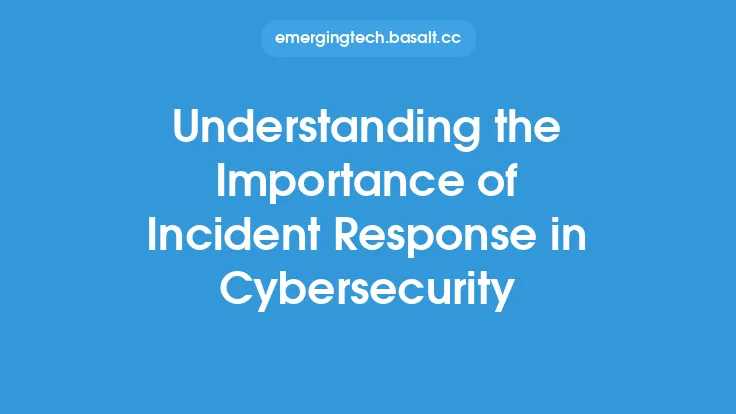Cryptography plays a vital role in the realm of cybersecurity, serving as a crucial line of defense against unauthorized access, data breaches, and other malicious activities. At its core, cryptography is the practice of secure communication by transforming plaintext (readable data) into ciphertext (unreadable data) to protect it from interception and eavesdropping. This transformation is achieved through the use of algorithms and protocols that ensure the confidentiality, integrity, and authenticity of data.
Importance of Cryptography in Cybersecurity
The importance of cryptography in cybersecurity cannot be overstated. As the world becomes increasingly digital, the need to protect sensitive information from cyber threats has never been more pressing. Cryptography provides a robust solution to this problem by ensuring that data remains confidential and tamper-proof, even in the event of a breach. This is particularly important for organizations that handle sensitive information, such as financial institutions, healthcare providers, and government agencies. By using cryptography to protect their data, these organizations can prevent unauthorized access, maintain the trust of their customers, and avoid the financial and reputational consequences of a data breach.
Types of Cryptographic Techniques
There are several types of cryptographic techniques used in cybersecurity, each with its own strengths and weaknesses. Symmetric encryption, for example, uses the same key for both encryption and decryption, making it fast and efficient. However, it requires the secure exchange of keys between parties, which can be a challenge. Asymmetric encryption, on the other hand, uses a pair of keys: a public key for encryption and a private key for decryption. This approach provides better security and scalability, but is generally slower than symmetric encryption. Hash functions and digital signatures are also essential cryptographic techniques, used to verify the integrity and authenticity of data.
Cryptographic Protocols and Standards
Cryptography is not just about algorithms and techniques; it also involves protocols and standards that govern how these techniques are used in practice. Secure Sockets Layer/Transport Layer Security (SSL/TLS), for example, is a cryptographic protocol used to secure web communications. It provides end-to-end encryption, authentication, and integrity checking, making it a crucial component of online security. Other important protocols and standards include Internet Protocol Security (IPSec), Secure Shell (SSH), and Pretty Good Privacy (PGP). These protocols and standards provide a framework for implementing cryptography in a way that is both secure and interoperable.
Cryptanalysis and Security Threats
Despite the power of cryptography, it is not foolproof. Cryptanalysis, the practice of breaking or weakening cryptographic algorithms, is a constant threat to the security of encrypted data. Side-channel attacks, quantum computer attacks, and social engineering attacks are just a few examples of the many threats that cryptography faces. To stay ahead of these threats, cryptographers must continually develop new algorithms and techniques, as well as improve existing ones. This is an ongoing process, as the security of cryptographic systems is constantly being tested and refined.
Implementation and Deployment
Implementing and deploying cryptography in a real-world setting can be complex and challenging. It requires careful consideration of factors such as key management, protocol selection, and system integration. Key management, in particular, is a critical aspect of cryptography, as it involves the secure generation, distribution, and storage of cryptographic keys. Poor key management can compromise the security of an entire system, making it essential to get it right. Additionally, cryptography must be integrated with other security measures, such as firewalls, intrusion detection systems, and access controls, to provide comprehensive protection.
Future of Cryptography in Cybersecurity
The future of cryptography in cybersecurity is exciting and rapidly evolving. Emerging technologies such as quantum computing, artificial intelligence, and the Internet of Things (IoT) are creating new opportunities and challenges for cryptography. Quantum computing, for example, has the potential to break certain types of encryption, but it also enables new types of quantum-resistant cryptography. Artificial intelligence and machine learning are being used to develop more sophisticated cryptographic techniques, such as homomorphic encryption and secure multi-party computation. As the cybersecurity landscape continues to evolve, cryptography will play an increasingly important role in protecting data and communications.
Conclusion
In conclusion, cryptography is a vital component of cybersecurity, providing a robust solution to the problem of secure communication in the digital age. Its importance cannot be overstated, as it protects sensitive information from unauthorized access, data breaches, and other malicious activities. By understanding the different types of cryptographic techniques, protocols, and standards, as well as the challenges and threats that cryptography faces, we can better appreciate the critical role that cryptography plays in maintaining the security and integrity of our digital world. As technology continues to evolve, cryptography will remain an essential tool in the fight against cyber threats, protecting our data, communications, and way of life.





